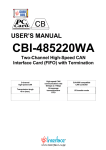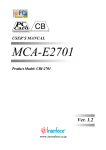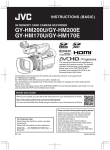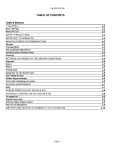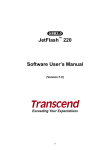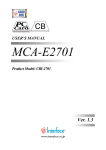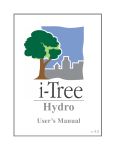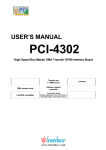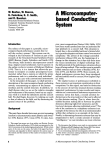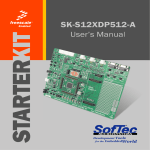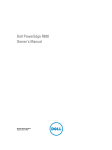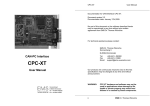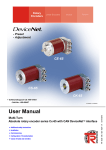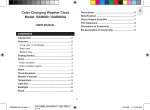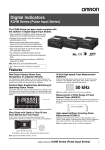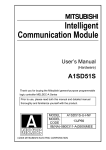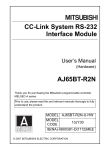Download CBI-485120WB
Transcript
USER’S MANUAL CBI-485120WB 2-Channel High-Speed CAN (D-Sub Adapter) 2-channel high-speed CAN Transmission length 40 m (max.) High-speed CAN communications rate 60 kbps to 1Mbps 64-byte transmit/receive FIFO www.interface.co.jp SJA1000 compatible CAN controller I/O transfer mode Notes to Users The specifications of the product are under continuous improvement and while every effort is made to keep this manual up-to-date, we reserve the right to update the contents of this user’s manual without prior notice. Therefore, you should thoroughly read this user’s manual even if you have often purchased this product before. Using this product requires technical knowledge of hardware and software. Use this product only under the specified conditions such as power supply, voltage, temperature, and humidity range. Interface Corporation’s products are not designed with components intended to ensure a level of reliability suitable for use under conditions that might cause serious injury or death. Please consult our Technical Support Center if you intend to use our products for special purpose, such as use for moving vehicles, medical treatment, aerospace engineering, controlling nuclear power, submerged translators and so on. This product is made under strict quality management, however, when using this product for the purposes that may result in any damages, lost profits, or any other incidental or consequential damages resulting from breakdown of this product, the user is required to take adequate and appropriate measures, such as installing safety devices to avoid possible serious accidents. Conventions Used in This Manual This icon denotes a warning, which advises you of precautions to take to avoid injury, data loss, or system crash. This icon denotes a note, caution, or warning. Indemnification Interface Corporation makes no warranties regarding damages resulting from installation or use of this product, whether hardware or software, and the user assumes all risk. Interface Corporation shall not be liable for any incidental or consequential damages, including damages or other costs resulting from defects which might be contained in the product, product supply delay or product failure, even if advised of the possibility thereof. Customer’s right to recover damages caused by fault or negligence on the part of Interface Corporation shall be limited to the amount paid by the customer for that product. This product including its software may be used only in Japan. Interface Corporation cannot be responsible for the use of this product outside Japan. Interface Corporation does not provide technical support service outside Japan. Warranty Interface Corporation products are warranted for a period of either one year or two years from the date of shipment, as evidenced by receipts or other documentation. This warranty does not apply to the software products and expendable supplies such as batteries. Note: You can determine the warranty period at our Web site by the serial number of your product. Those without Internet access should contact the Sales Information Center. During the warranty period Interface Corporation will, as a general rule, replace or recondition the defective product without charge, in which case the user will be required to pay the shipping costs, except as set forth below. The Warranty provided herein does not cover expendable supplies such as batteries and damages, defects, malfunctions, or failures caused by impact during transportation while under owner’s responsibility; owner’s failure to follow the instructions and the precautions contained in this manual; modification and/or repair of the product by other than Interface Corporation, trouble caused by use with peripherals not specified by Interface Corporation, power failure or surges, fire, earthquake, tidal wave and/or flood. This warranty applies only when the product is used in Japan. Interface Corporation warrants its repairs for six months, and will again repair the same defective part without additional charge provide the product is economically repairable. In that case, the user should attach a copy of the most recent repair report to the repair request form. If no repair report is attached, it will be considered as a new repair request. Before You Export Interface Products The foreign exchange and foreign trade law of Japan controls the export of this product, due to its possible use as a STRATEGIC MATERIAL. Therefore, before you export this product, you must secure an export permit from the Ministry of Economy, Trade and Industry of Japan. CBI-485120WB Revision History Version 1.0 Date March 2005 Comments User’s manual MCA-E485120WB published. Due to constant product improvements, the information in this user’s manual is subject to change without prior notice. -1- Interface Corporation CBI-485120WB Chapter 1 -ContentsIntroduction............................................................................... 3 1.1 Summary............................................................................................................................... 3 1.1.1 Features ................................................................................................................. 3 Chapter 2 Signal Definitions...................................................................... 4 2.1 Cable Connector Pin Assignments ....................................................................................... 4 2.1.1 Signals ................................................................................................................... 4 2.1.2 Acceptable Cable Connector.................................................................................. 4 Chapter 3 Specifications ........................................................................... 5 3.1 Hardware Specifications ....................................................................................................... 5 3.2 Electric Characteristics ......................................................................................................... 6 3.2.1 Absolute Maximum Rating ..................................................................................... 6 3.2.2 Recommended Operating Environment ................................................................. 6 3.2.3 DC Specifications................................................................................................... 6 3.3 Circuit Diagram ..................................................................................................................... 7 3.4 External Input/Output Circuit ................................................................................................. 7 3.5 CAN controller Access .......................................................................................................... 8 Chapter 4 External Connections ............................................................... 9 4.1 Example Connection............................................................................................................. 9 Chapter 5 Installation .............................................................................. 10 5.1 Card Installation .................................................................................................................. 10 5.2 Driver Software Installation ................................................................................................. 10 5.3 Card Uninstallation.............................................................................................................. 10 5.4 Multiple CardBus Cards ...................................................................................................... 11 Chapter 6 Glossary ................................................................................. 12 6.1 List of Definitions................................................................................................................. 12 Chapter 7 Notes for Users ...................................................................... 13 7.1 Caution, Periodic Inspections, and Storage ........................................................................ 13 Chapter 8 Troubleshooting...................................................................... 15 8.1 Checkpoints ........................................................................................................................ 15 Interface Corporation -2- CBI-485120WB Chapter 1 Introduction 1.1 Summary The CBI-485120WB is a CAN (Controller Area Network) Interface card for CardBus-based computers. Two high-speed communications channels compliant with ISO11898-2 are achieved with the SJA1000 CAN controller (Royal Philips Electronics or equivalent) and PCA82C250 CAN transceiver (Royal Philips Electronics or equivalent). The maximum bit rate is 1 Mbps. Each channel provides independent communications at individually set bit rates. Packing List Item CardBus Card Cable Part Number CBI-485120WB JKC-4851B Qty. 1 1 1.1.1 Features 1. CAN protocol The CBI-485120WB can perform high-speed CAN communications compliant with the CAN 2.0B protocol and ISO11898-2. This product uses the SJA1000 CAN controller (Royal Philips Electronics or equivalent) and PCA82C250 CAN transceiver (Royal Philips Electronics or equivalent). The maximum bit rate is 1 Mbps. 2. One CAN controller for each channel The CBI-485120WB incorporates one CAN controller per channel. Each channel provides independent communications at individually set bit rates. The system clock frequency is 24 MHz. 3. High-performance CAN controller By adopting the SJA1000 CAN controller, the following functions are provided: error code capture, error count, two receiver message filters, and so on. 4. Receive FIFO The SJA1000 CAN controller features an internal 64-byte FIFO. Data loss is prevented even at high-speed communications rates. -3- Interface Corporation CBI-485120WB Chapter 2 Signal Definitions 2.1 Cable Connector Pin Assignments • CN1, CN2 <CN1> <CN2> NC CAN_H1 NC NC 6 7 8 9 1 2 3 4 5 NC CAN_L1 GND NC NC NC CAN_H2 NC NC 6 7 8 9 NC: Not connected Connector catalog number: 17JE-23090-02(DC2C) Screw: #4-40UNC 2.1.1 Signals Signal Description Signal CAN_L CAN_H GND Pin Number 2 7 3 Direction Input/Output Description CAN Low CAN High Ground Note: Connect the cable only with the CBI-485120WB. 2.1.2 Acceptable Cable Connector 9-pin D-sub female connector Connector catalog number: GM-9LFU (Honda Tsushin Kogyo Co., Ltd.) or equivalent Interface Corporation -4- 1 2 3 4 5 NC CAN_L2 GND NC NC CBI-485120WB Chapter 3 Specifications 3.1 Hardware Specifications Parameter Number of channels Communications standards Bit rate CAN controller CAN transceiver CAN controller system clock frequency Transmit/receive buffer memory Memory size Maximum cable length Number of connection units Power consumption Bus requirements Card size Environmental conditions On-card connector Specification 2 CAN2.0B protocol-based, ISO11898-2 High-speed CAN: 60 kbps to 1 Mbps SJA1000 (Royal Philips Electronics) or equivalent PCA82C250 (Royal Philips Electronics) or equivalent 24 MHz 64 bytes for receive each channel 4 kB × 2 40 m 30 (max.) +3.3 Vdc (+/-0.3 V): 0.3 A (typ.) PC Card Standards-Based CardBus PCMCIA/JEITA Type II Operating temperature: 0 °C to 50 °C Relative humidity: 20% to 90% (non-condensing) CN1, CN2: 9-pin D-sub male connector (attached cable connection) -5- Interface Corporation CBI-485120WB 3.2 Electric Characteristics This chapter shows the electric characteristics of the CBI-485120WB. 3.2.1 Absolute Maximum Rating Item Min. Max. CAN_H, CAN_L input voltage -8 V +18 V Input potential difference between CAN_H and CAN_L -1.0 V +5.0 V 3.2.2 Recommended Operating Environment Item CAN_H input voltage CAN_L input voltage Input potential difference between CAN_H and CAN_L Min. 2.0 V 0.5 V Max. 4.5 V 3.0 V -0.5 V 3.0 V 3.2.3 DC Specifications Item CAN_H output voltage CAN_L output voltage Input potential difference between CAN_H and CAN_L CAN_H output current CAN_L output current Input potential difference between CAN_H and CAN_L (Recessive) Input potential difference between CAN_H and CAN_L (Dominant) Interface Corporation Bus Level Recessive Dominant Recessive Dominant Dominant, no load Dominant, load: 45 Ω Recessive CAN_H external voltage: -5 V CAN_H external voltage: +18 V -2 V < Voltage for CAN_H, Voltage for CAN_L < +7 V -7 V < Voltage for CAN_H, Voltage for CAN_L < +12 V -2 V < Voltage for CAN_H, Voltage for CAN_L < +7 V -7 V < Voltage for CAN_H, Voltage for CAN_L < +12 V -6- Min. 2.0 V 2.75 V 2.0 V 0.5 V 1.5 V 1.5 V -500 mV Max. 3.0 V 4.5 V 3.0 V 2.25 V 3.0 V +50 mV -105 mA +160 mA -1.0 V +0.5 V -1.0 V +0.4 V +0.9 V +5.0 V +1.0 V +5.0 V CBI-485120WB 3.3 Circuit Diagram FPGA Same as channel 1 CN2 OSC 24 MHz Interrupt CN1 CAN transceiver PC card connector Branch cable connector Register access CAN controller CardBus bridge circuit Control circuit CardBus Channel 1 Channel 2 3.4 External Input/Output Circuit The figure below shows the external input/output circuit of the CBI-485120WB. CAN Transceiver CAN_H1 120 Ω R PCA82C250 CAN_L1 Channel 2 CAN Transceiver PCA82C250 CAN_H2 120 Ω R CAN_L2 -7- CN2 Channel 1 CN1 CBI-485120WB JKC-4851B: PC card connector Branch cable connector (without terminating resistor) Interface Corporation CBI-485120WB 3.5 CAN controller Access The CBI-485120WB can directly access all registers of the SJA1000 CAN controller. Moreover, an interrupt request is issued for CardBus by the controller interrupt signal. Basic CAN mode and Peli CAN mode are selectable. • Basic CAN mode It is the mode which is compatible with the conventional PCA82C200 CAN controller (Royal Philips Electronics or equivalent). The contents and arrangement of a register are the same. • Peli CAN mode It is the mode which added the extended function to the conventional CAN controller. It has such function as 64-byte receive FIFO. More advanced communications control can be performed by using the extended function. Register access Interrupt CAN controller CardBus bridge circuit Control circuit CardBus Notes: • When using our driver software, this card can be used regardless of CAN controller modes. Moreover, driver software cannot control CAN controller directly. • When controlling this card directly without using our driver software, refer to the data sheet of the SJA1000 CAN controller or I/O map. Interface Corporation -8- CBI-485120WB Chapter 4 External Connections 4.1 Example Connection The figure below shows example connection of the CBI-485120WB. Other CAN interfaces (with terminating resistor) Signal CAN_L CAN_H GND CBI-485120WB (without terminating resistor) Pin Number 2 7 3 Signal CAN_L CAN_H GND Other CAN interfaces (with terminating resistor) Signal CAN_L CAN_H GND Note: To avoid an error, connect a CAN Interface with terminating resistor to the both ends of the network. -9- Interface Corporation CBI-485120WB Chapter 5 Installation BE SURE TO ELIMINATE STATIC ELECTRICITY OF YOUR BODY BEFORE YOU INSTALL OR REMOVE THIS PRODUCT. 5.1 Card Installation When you install this product in your system, read the manual of your system which refers to the PC card slot. 1. Make sure that the system is turned off and the power cable is unplugged. (This card corresponds to Hot Swap. You can insert this card when the system turns on.) 2. Insert the card into the PC card slot in your system. 3. Plug in the power cord, and turn on the system. ! Be careful of the insert direction when you insert this product into your system to avoid system damage. ! The attached cable may interfere with the card cable connector for the adjacent slot or computer because of the connector form of the attached cable. The figure below shows an example. Attached cable connector PC card Another cable connector Computer 5.2 Driver Software Installation Refer to our Web site for the Help of each optional software when you install and use it. 5.3 Card Uninstallation The method of removing PC card from your system differs depending on each system. Please read the manual of your system. ! Do not remove this product when accessing to the external equipment. Your system may not operate correctly. Interface Corporation -10- CBI-485120WB 5.4 Multiple CardBus Cards When using multiple cards in one system, it is required to write the CardBus ID number to the ROM in the card. The CardBus ID configuration utility program in the software can configure the number. Refer to Help files for more details. Notes: • Write the configured CardBus ID number on the back side of each card to easily confirm the number. • Please download and use the newest version about software. The following example shows the CardBus ID number is “0.” Color seal 0 Back side of the card -11- Interface Corporation CBI-485120WB Chapter 6 Glossary 6.1 List of Definitions The list below explains a selection of technical terms used in this manual. Term Definition CAN CAN is an acronym for Controller Area Network. Standardized by ISO as a serial communications protocol, CAN was developed by the German electrical equipment manufacturer, BOSCH, for use in automotive networks. After being regulated by ISO, CAN soon became the de-facto standard in the automobile industry. CAN technology is now used in various other fields such as factory automation, agriculture, medical equipment, nautical craft, and also DeviceNet. ISO11898-2 The high-speed CAN communications standard. The bit rate range is between 125 kbps and 1 Mbps. It may not be connected to a fault-tolerant CAN bus. Terminating resistor The resistor used in order to minimize reflection of an electric signal, also called a terminator. Dominant A logical 0 is represented by the dominant bit. When a dominant bit and recessive bit are output simultaneously by two different drivers on the same bus, only the dominant bit is observed on the bus signal line. Recessive A logical 1 is represented by the recessive bit. When the bus is in the idle state, a recessive bit is observed on the bus signal line. Interface Corporation -12- CBI-485120WB Chapter 7 Notes for Users For your safety, follow all warnings and instructions described in this manual. 7.1 Caution, Periodic Inspections, and Storage Failure to follow this warning may result in electric shock, burns, serious injury, and in some cases, even cause death. ! Warning! z Keep this product away from flammable gases. Use this product only under the conditions as shown below. Environmental Specifications Parameter Specification Temperature Range 0 °C to 50 °C Relative Humidity Range 20% to 90% (non-condensing) Dust Typical office environment Corrosive Gas None Noise Far from power source and its wiring Voltage Requirements CardBus specification: +3.3 Vdc (+/-0.3 V) The following inspections should be carried out on this card periodically. Periodic Inspections Item Cable Connections Connector Contacts Checkpoint Be sure that all connectors and cables are installed correctly. Check for dirt or corrosion. -13- Interface Corporation CBI-485120WB TO AVOID DAMAGE TO THE CARD AND POSSIBLE INJURY, TAKE APPROPRIATE PRECAUTIONS AS DESCRIBED BELOW WHEN HANDLING IT. Caution! ! This card should be stored exactly the same way as when it was received. Proceed as follows: 1. Put the card back in its PC card case. 2. Wrap the PC card case with the original packing material. 3. Avoid excessive humidity. 4. Do not expose the card to the direct rays of the sun. 5. Store the card at room temperature. ! Do not modify the card. Interface Corporation assumes no liability for any malfunctions resulting from users’ unauthorized modification of the card. ! Take measures to avoid and minimize shock, vibration, magnetic fields, and static electricity in the storage or operating environment of this card. ! Make sure that the card is disconnected from the cable before inserting or removing any cards. ! Please keep the attached cable in a horizontal position for approximately 10 cm from the card connection part as below, and fix it not to move, even if stress starts. The connector may be dameged, if the 10N (approximately 1kgf) or more loads are added its connection part. CBI-485120WB Fixed Attached cable Approximately 10 cm computer Interface Corporation -14- CBI-485120WB Chapter 8 Troubleshooting 8.1 Checkpoints Problem Data cannot be transferred correctly. Communications are not reliable. A transmit/receive error occurs. The computer does not respond after Standby mode. (Input and output are disabled.) The computer does not recognize this card. Solution Double-check all cable connections. To use the multiple CardBus cards, configure the CardBus ID number by using the CardBus ID utility program. In case multiple Interface CardBus cards of the same type are installed in the same system, the ID number on each Interface CardBus card is used to uniquely identify each card. If the pins are connected incorrectly, the data cannot be transmitted. Make sure that there are no incorrect connections. If the communications parameters for transmitter and receiver are not the same values, the data cannot be correctly transmitted. Configure them to be the same. If the power requirements exceed the system power budget, the circuits on the card or connected external circuits cannot be powered properly. Prepare an external power supply for your CardBus card. Check whether the selected terminating resistor is suitable for your system. Refer to “3.4 External Input/Output Circuit,” page 7. Set the System standby setting to “Never”. Use the PCI device viewer (BPF-0801) to examine the CardBus card on your computer. Please send the result to our Technical Support Center by fax or e-mail. The PCI device viewer may be downloaded from our Web site free of charge. -15- Interface Corporation CBI-485120WB -IndexB I Basic CAN mode .................................................. 8 ISO11898-2..................................................3, 5, 12 C P CAN..................................................................... 12 CAN controller.................................................. 5, 8 CAN protocol........................................................ 3 CAN transceiver.................................................... 5 Card uninstallation .............................................. 10 PCA82C200...........................................................8 PCA82C250.......................................................3, 5 PCI device viewer................................................15 Peli CAN mode......................................................8 R D Recessive..........................................................6, 12 Dominant......................................................... 6, 12 S E Signal description ..................................................4 SJA1000.............................................................3, 5 Electric characteristics........................................... 6 Environmental specifications ............................. 13 T F Terminating resistor.............................................12 FIFO....................................................................... 3 Interface Corporation -16- For Assistance: If you would like to inquire our products, please contact below. E-mail URL [email protected] www.interface.co.jp/support/ Repair and Maintenance: We provide repair and maintenance service for your damaged product. If you need this service, please refer to “Repair and Maintenance” of a user’s manual of Japanese version and follow the procedures for repair and maintenance applications. PLEASE NOTE: We do not accept the repair for the product which is not used in Japan. If you use our products in other countries, please contact the store where you purchased them. You can download a user’s manual of Japanese version from our Web site below. URL: www.interface.co.jp Visit our Web site (www.interface.co.jp) for: Various services listed below are provided on our Web site. Product Information The latest information about our products; specifications, product selection guides, etc Technical Support Online questions and answers, rental service, frequently asked questions, and glossary Sales Mail order, distributors list Downloads Service User’s manual, software, and tutorial The design and contents of the Web site are under constant review. Therefore, there might be some changes in its design and contents. is a trademark of Interface Corporation (under application). is a collective mark of Japan Electronics and Information Technology Industries Association (JEITA). Other product and company names are trademarks, registered trademarks, or servicemarks of their respective owners. 2005 Interface Corporation All rights reserved. No part of this publication may be reproduced or altered in any form or by any means without the written permission of Interface Corporation. MCA-E485120WB Ver. 1.0 Vol. 1/1





















